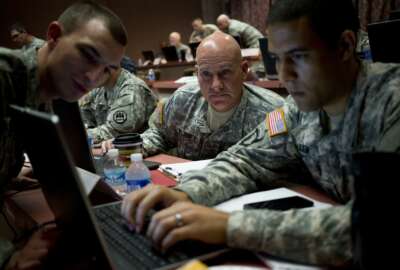After just a few days on the job, the Army’s new top official for information technology minced no words when he described the service’s IT enterprise: The network the Army has is not the network it needs for its future missions.
So exactly what kind of network does the Army need? Stay tuned.
Maj. Gen. Bruce Crawford, who became the Army’s chief information officer/G-6 on Aug. 1, said many of those questions will be answered by an ongoing senior-level review ordered by Gen. Mark Milley, the Army chief of staff, who has previously said he considers the service’s tactical networking systems to be too fragile and insecure to successfully operate in the “multi-domain battle” environment he envisions for the future.
And although the review is likely to have a major impact on the future of battlefield systems, like the Army’s $6 billion Warfighter Information Network-Tactical (WIN-T), Crawford emphasized it’s about much more than that. The review also encompasses business systems, intelligence systems and enterprise-wide systems.
“If you look at something like the [Global Combat Support System-Army], you might consider that an enterprise resource planning tool, but it lives in our tactical formations,” Crawford told AFCEA’s TechNet conference in Augusta, Georgia last week. “So our assessment can’t just be about one of the mission areas. It’s got to be about the whole thing in order to get the network we need not the network that we have. Individually, as we think about these four mission areas that make up what we call ‘the network,’ they’re all critical enablers to the warfighter individually. But collectively, they transform into a force multiplier that allows us to fully leverage and employ the Army’s network as a weapon system.”
And although the Army hasn’t yet fully mapped out what the new network will look like, Crawford said the intellectual shift — imagining the entire thing as a weapons system — was a first for his service, and that the Army has already developed a list of 17 “first principles” and requirements toward that end.
Boiled down to their essence, the requirements are straightforward, although ambitious.
“The warfighter and the enablers must be able to shoot, they must be able to move, they must be able to communicate, they must be able to protect and sustain, anywhere, anytime, in all domains against any foe,” Crawford said. “It’s as simple as that.”
And the individual systems that make up the network need to get a lot simpler, more intuitive, and standards-based.
“There’s work to be done to achieve that, and I realize that we’re going to have to attack the enterprise piece in order to get there, because that’s where the infrastructure is. But it’s got to be simple, it’s got to be intuitive, and it’s got to be installed, operated and maintained by soldiers,” Crawford said.
The Army has already begun to take some steps to simplify its battlefield IT capabilities, much of which are made up of disparate technologies that were purchased over the past 15 years of counterinsurgency warfare to suit a given purpose within a certain unit at a given time.
In May, the Army issued a service-wide directive telling all of its units to converge around a common set of mission command hardware and software by 2019. In late July, the service’s Program Executive Office for Command, Control and Communications-Tactical (PEO-C3T) said it would implement the order with a sweeping two-year project that would update the equipment of some 400 formations in the active duty Army, the Army Reserve and the National Guard.
PEO-C3T expects to deploy new hardware and software that meets the demand for a common hardware and software baseline for 280 of those units over the next year, using an accelerated version of an existing Army process called “unit set fielding,” the mechanism the Army has used since 2006 to deploy technical updates to units in a way that meshes with their pre-planned training and deployment schedules.
“Through unit set fielding, we typically touch between 80 and 100 units per year,” said Thane St. Clair, the branch chief in charge of materiel fielding for PEO-C3T. “The Army is asking us to do in two years what we normally do in a five-year process. This is a key readiness effort, so we increased the size of our new equipment training team from 28 to 94 people to have the global reach to get the job done.”
Going forward, although the network review is not yet complete, Crawford signaled that its impacts on the Army’s modernization strategy will cause the service to look askance at vendors who offer proprietary technologies.
“In the old days, meaning five months ago, the discussion about buying radios would have gone something like this: ‘I need one radio to go on this person’s back, but I got to buy this other radio to go on a vehicle because it comes with an installation kit to go on this particular vehicle, and another one for another vehicle,’” he said. “We need things like universal installation kits. We’ve got to come to grips with the fact that proprietary doesn’t work for us anymore. I get that that’s the business model for a lot of companies, and I would probably be doing the same thing. But as we evolve to a completely different model for our network, we know that the status quo is not going to be the norm. We can do better than that.”
Copyright
© 2024 Federal News Network. All rights reserved. This website is not intended for users located within the European Economic Area.
